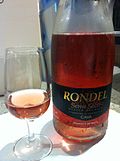Sweetness of wine
Introduction[edit]
Sweetness of wine is a significant aspect of wine tasting that refers to the levels of residual sugar in wine after fermentation, which affects the overall taste and flavor of the wine. The sweetness of wine can range from very dry, dry, off-dry, semi-sweet, sweet, to very sweet.
Factors Influencing Sweetness of Wine[edit]
The sweetness of wine is primarily determined by the winemaking process, specifically the point at which fermentation is stopped. If fermentation is allowed to continue until all sugar is converted into alcohol, the resulting wine will be dry. If fermentation is stopped before all sugar is converted, the wine will retain some residual sugar, making it sweeter.
Grape Variety[edit]
The grape variety used in winemaking also plays a significant role in the sweetness of wine. Some grape varieties naturally have higher sugar content, which can contribute to a sweeter wine. Examples of such grape varieties include Muscat, Riesling, and Gewürztraminer.
Climate[edit]
The climate where the grapes are grown can also influence the sweetness of wine. Grapes grown in warmer climates tend to have higher sugar content, resulting in sweeter wines. Conversely, grapes grown in cooler climates tend to produce more acidic, less sweet wines.
Classification of Wine Sweetness[edit]
Wine sweetness is typically classified on a scale from dry to sweet. This classification is based on the amount of residual sugar in the wine, measured in grams per liter (g/L).
Dry Wines[edit]
Dry wines have the least amount of residual sugar, typically less than 10 g/L. Examples of dry wines include Cabernet Sauvignon, Merlot, and Chardonnay.
Off-Dry Wines[edit]
Off-dry wines, also known as semi-dry wines, have slightly more residual sugar than dry wines, typically between 10-20 g/L. Examples of off-dry wines include Pinot Gris, Gewürztraminer, and Riesling.
Semi-Sweet Wines[edit]
Semi-sweet wines have a noticeable sweetness, with residual sugar levels typically between 20-50 g/L. Examples of semi-sweet wines include Moscato, Riesling, and Chenin Blanc.
Sweet Wines[edit]
Sweet wines have a high level of residual sugar, typically over 50 g/L. Examples of sweet wines include Port, Sherry, and Sauternes.
Conclusion[edit]
Understanding the sweetness of wine can enhance the wine tasting experience, allowing individuals to better appreciate the complexity and nuances of different wines. Whether one prefers dry, off-dry, semi-sweet, or sweet wines, there is a wide variety of wines to suit every palate.
Sweetness_of_wine[edit]
-
Sweetness of wine
-
Sweetness of wine
-
Sweetness of wine
-
Sweetness of wine
Ad. Transform your life with W8MD's Budget GLP-1 injections from $75


W8MD offers a medical weight loss program to lose weight in Philadelphia. Our physician-supervised medical weight loss provides:
- Weight loss injections in NYC (generic and brand names):
- Zepbound / Mounjaro, Wegovy / Ozempic, Saxenda
- Most insurances accepted or discounted self-pay rates. We will obtain insurance prior authorizations if needed.
- Generic GLP1 weight loss injections from $75 for the starting dose.
- Also offer prescription weight loss medications including Phentermine, Qsymia, Diethylpropion, Contrave etc.
NYC weight loss doctor appointmentsNYC weight loss doctor appointments
Start your NYC weight loss journey today at our NYC medical weight loss and Philadelphia medical weight loss clinics.
- Call 718-946-5500 to lose weight in NYC or for medical weight loss in Philadelphia 215-676-2334.
- Tags:NYC medical weight loss, Philadelphia lose weight Zepbound NYC, Budget GLP1 weight loss injections, Wegovy Philadelphia, Wegovy NYC, Philadelphia medical weight loss, Brookly weight loss and Wegovy NYC
|
WikiMD's Wellness Encyclopedia |
| Let Food Be Thy Medicine Medicine Thy Food - Hippocrates |
Medical Disclaimer: WikiMD is not a substitute for professional medical advice. The information on WikiMD is provided as an information resource only, may be incorrect, outdated or misleading, and is not to be used or relied on for any diagnostic or treatment purposes. Please consult your health care provider before making any healthcare decisions or for guidance about a specific medical condition. WikiMD expressly disclaims responsibility, and shall have no liability, for any damages, loss, injury, or liability whatsoever suffered as a result of your reliance on the information contained in this site. By visiting this site you agree to the foregoing terms and conditions, which may from time to time be changed or supplemented by WikiMD. If you do not agree to the foregoing terms and conditions, you should not enter or use this site. See full disclaimer.
Credits:Most images are courtesy of Wikimedia commons, and templates, categories Wikipedia, licensed under CC BY SA or similar.
Translate this page: - East Asian
中文,
日本,
한국어,
South Asian
हिन्दी,
தமிழ்,
తెలుగు,
Urdu,
ಕನ್ನಡ,
Southeast Asian
Indonesian,
Vietnamese,
Thai,
မြန်မာဘာသာ,
বাংলা
European
español,
Deutsch,
français,
Greek,
português do Brasil,
polski,
română,
русский,
Nederlands,
norsk,
svenska,
suomi,
Italian
Middle Eastern & African
عربى,
Turkish,
Persian,
Hebrew,
Afrikaans,
isiZulu,
Kiswahili,
Other
Bulgarian,
Hungarian,
Czech,
Swedish,
മലയാളം,
मराठी,
ਪੰਜਾਬੀ,
ગુજરાતી,
Portuguese,
Ukrainian




